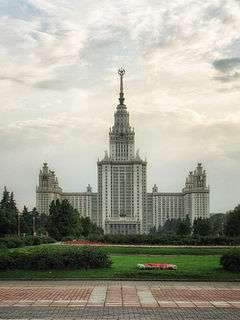Main building of Moscow State University
| Main building of Moscow State University | |
|---|---|
| Гла́вное зда́ние МГУ | |
 | |
| General information | |
| Status | in use |
| Type | Educational |
| Location | 1 Leninskiye Gory, Moscow, Russia |
| Coordinates | 55°42′11″N 37°31′49″E / 55.70306°N 37.53028°ECoordinates: 55°42′11″N 37°31′49″E / 55.70306°N 37.53028°E |
| Construction started | 1949 |
| Completed | 1953 |
| Opening | 1953-09-01 |
| Management | Moscow State University |
| Height | |
| Antenna spire | 240 m (790 ft) |
| Roof | 182 m (597 ft) |
| Technical details | |
| Floor count | 36 |
| Design and construction | |
| Architect | Lev Rudnev |
| Structural engineer | Vsevolod Nikolaevich Nasonov |
| References | |
| [1] | |
The Main building of Moscow State University (in Russian Гла́вное зда́ние МГУ), designed by Lev Rudnev,[1] is the highest of seven Stalinist skyscrapers of Moscow. It is utilized since its inauguration as headquarters of the Lomonosov Moscow State University.
Features

The skyscraper has 36 levels in its central part and is 240 metres (790 ft) tall. Its roof (182 metres (597 ft)) is topped by a 57-metre spire which ends with a 12-ton five-pointed star. Lateral towers are lower than the central one; two 18 and 9 storey dormitory wings define, with the central corpus of the complex, a cour d'honneur courtyard.[2]
Among the statues which decorate the building can be remembered a Vera Muchina sculpture representing a couple of students and a statue of Mikhail Lomonosov (1711–1765), the founder of Moscow University, realized by N. Tomsky. University premises cover around 1,6 square kilometres; the complex was partially renovated in 2000.[3]
History
The leading architect Boris Iofan bid for the skyscraper project in 1947 but the job was assigned to Lev Rudnev, because Iofan made a mistake placing his draft skyscraper right on the edge of Sparrow Hills, a site concerned with a potential landslide hazard. Rudnev had already built important edifices like the Frunze Military Academy (1932–1937 ) and the Marshals' Apartments (Sadovaya-Kudrinskaya, 28, 1947), earning esteem of the Communist Party. He set the building 800 meters away from the cliff. The chief of the engineers' team was Vsevolod Nikolaevich Nasonov.[2]
The main tower, which consumed over 40,000 tons of steel for its framework and 130,000 cubic metres of concrete, was inaugurated on September 1, 1953.[4] At 240 metres tall, it was the 7th tallest building of the world [1] and also the tallest in Europe. Its European record lasted up to 1988, when it was surpassed by MesseTurm.[3] It is still the tallest educational building in the world.[5]
Moscow University is probably the best known of Lev Rudnev buildings, for which he was awarded the Stalin Prize in 1949. The University skyline inspired various buildings in the socialist countries, like the Palace of Culture and Science in Warsaw, and also the logo of 1980 Moscow Olympic Games.[3]
See also
Notes
- 1 2 3 Binder, Georges (2006). 101 of the World's Tallest Buildings. Images Publishing. p. 10.
- 1 2 "Moscow State University main building". um.mos.ru. Discover Moscow. Retrieved 2016-07-22.
- 1 2 3 "omonosov Moscow State University Main Building". EMPORIS GMBH. Retrieved 2016-07-22.
- ↑ "The Campus on Lenin Hills: yesterday, today, tomorrow". Moscow State University. Retrieved 2016-07-22.
- ↑ "10 Tallest University Buildings in the World". Retrieved 2016-07-22.
External links
-
 Media related to Main building of Moscow State University at Wikimedia Commons
Media related to Main building of Moscow State University at Wikimedia Commons - "Building data at emporis.com".
- "History of Moscow Skyscrapers" (in Russian).
| Records | ||
|---|---|---|
| Preceded by Kotelnicheskaya Embankment Building |
Tallest Building in Europe 1953–1990 240 m |
Succeeded by Messeturm |
| Preceded by None |
Tallest Building in the Former Soviet Union 1991–2005 240 m |
Succeeded by Triumph Palace |
| Preceded by Kotelnicheskaya Embankment Building |
Tallest Building in the Soviet Union 1953–1991 240 m |
Succeeded by None |
| Preceded by None |
Tallest Building in Russia 1991–2005 240 m |
Succeeded by Triumph Palace |
| Preceded by Kotelnicheskaya Embankment Building |
Tallest Building in the Russian SFSR 1953–1991 240 m |
Succeeded by None |
| Preceded by Kotelnicheskaya Embankment Building |
Tallest Building in Moscow 1953–2005 240 m |
Succeeded by Triumph Palace |